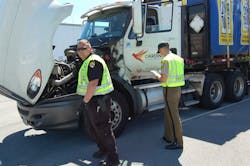Violations for brake systems, cargo securement, and tires/wheels were the top causes vehicles were placed out of service during the Commercial Vehicle Safety Alliance’s (CVSA) 2017 Roadcheck inspection blitz.
Commercial motor vehicle enforcement personnel in Canada and the United States conducted a total of 62,013 Level I, II and III driver and vehicle safety inspections on large trucks and buses during the blitz held June 6-8, 2017. According to CVSA, 23% of vehicles and 4.2% of drivers that received Level I inspections were placed out of service.
A Level I inspection is a 37-step procedure that includes examination of both the driver and vehicle. Other inspections conducted included the NAS Level II walk-around inspection (12,787) and the NAS Level III driver-only inspection (8,282).
International Roadcheck is a three-day enforcement event when CVSA-certified inspectors conduct high-volume roadside inspections of large trucks and buses. Commercial motor vehicles and their drivers were checked at inspection sites, weigh stations and roving patrol locations along roadways in North America throughout the 72-hour enforcement initiative.
CVSA noted that 19.4% of commercial motor vehicles inspected were placed out of service, and that 4.7% of all drivers inspected were placed out of service.
Of the 40,944 Level I inspections conducted, 23% (9,398) were placed out of service for vehicle-related violations. The top three out-of-service vehicle violations were for:
- Brake systems (26.9 % of vehicle out-of-service violations)
- Cargo securement (15.7%)
- Tires/wheels (15.1%)
Of the 2,267 vehicles carrying hazardous materials/dangerous goods that received a Level I inspection, 12.8% were placed out of service for vehicle-related violations. The top three vehicle violations related to the transportation of hazardous materials/dangerous goods were for:
- Loading and securement (40.4% of all out-of-service hazardous materials/dangerous goods violations)
- Shipping papers (22.7%)
- Placarding (20.8%)
Of the vehicles placed out of service, brake adjustment and brake system violations combined to represent 41.4% (7,743) of all out-of-service vehicle violations.
According to CVSA, driver results are as follows:
- 4.7% (2,940) of drivers were placed out of service for driver-related violations.
- Of the inspections of vehicles carrying hazardous materials/dangerous goods, 1.9% were placed out of service for driver-related violations.
- Out of the 598 motorcoaches inspected, 3.8% (23) of drivers were placed out of service for driver-related violations.
- The top three driver-related violations were for hours of service (32.3% of driver out-of-service violations), wrong class license (14.9%) and false log book (11.3%).
- There were 710 safety belt violations.
Each year, Roadcheck places special emphasis on a category of violations. This year’s focus was cargo securement. Cargo securement violations (not including hazardous materials/dangerous goods loading/securement) represented 15.7% of all vehicle out-of-service violations during the inspection blitz.
According to CVSA’s data, the top five violations related to cargo securement (out of a total of 3,282) in the United States were:
- No or improper load securement (423)
- Failure to secure vehicle equipment (379)
- Leaking, spilling, blowing, falling cargo (281)
- Insufficient tiedowns to prevent forward movement for load not blocked by headerboard, bulkhead or cargo (256)
- Failure to secure load (178)
“This year, we’re celebrating 30 years of the International Roadcheck Program,” said CVSA president Julius Debuschewitz with Yukon Highways and Public Works. “When this program started in 1988, the goal of International Roadcheck was to conduct inspections to identify and remove unsafe commercial motor vehicles and/or drivers from our roadways. Thirty years and 1.5 million inspections later, the International Roadcheck enforcement initiative is still going strong, thanks to the more than 13,000 inspectors who work hard every day to reduce the number of crashes, injuries and fatalities on our roadways.”
About the Author
Fleet Owner Staff
Our Editorial Team
Kevin Jones, Editorial Director, Commercial Vehicle Group
Cristina Commendatore, Executive Editor
Scott Achelpohl, Managing Editor
Josh Fisher, Senior Editor
Catharine Conway, Digital Editor
Eric Van Egeren, Art Director
